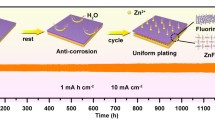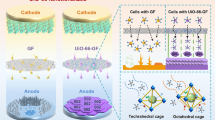Abstract
Low-cost, high-safety aqueous Zn-ion batteries show promise for large-scale energy storage, but the unsatisfactory cycling stability of Zn anodes and the lack of a suitable hydrophilic separator for rechargeable aqueous Zn batteries limit their practical applications. In this work, we report a scalable method for the preparation of a homogenous polyvinylidene fluoride-lithium bistrifluoromethanesulfonimide (LiTFSI) (PVDF-Li)-based separator for aqueous Zn batteries. The homogenously mixed LiTFSI salt interrupted the crystalline framework of PVDF with excellent mechanical strength and led to hierarchical pore structures for the rapid and uniform Zn2+ flux through the separator. Meanwhile, the PVDF-Li separator exhibited excellent wettability toward aqueous Zn electrolytes. With the advanced PVDF-Li separator, the Zn dendrite growth can be suppressed greatly, showing an improved cycle life. The Zn||V2O5 full cell with PVDF-Li separator exhibited a 27% higher initial capacity (324 mA h g−1) and considerably better capacity retention than the traditional glass fiber separator due to the uniform reaction on the V2O5 cathode and Zn anode sides. This work provides new insights into the development of high-performance aqueous batteries by regulating the reactions on the cathode and anode through functional separators.

摘要
水系锌离子电池具有低成本、 高安全的特点, 有望应用于大规模储能. 然而, 锌负极的循环稳定性仍不理想, 且水系电池缺少合适的亲水隔膜, 这限制了水系锌离子电池的实际应用. 在本文中, 我们报道了一种可用于水系电池的分级多孔的聚偏二氟乙烯-双三氟甲磺酰亚 胺锂(PVDF-LiTFSI) (PVDF-Li)隔膜. 均匀混合的LiTFSI盐降低了PVDF的结晶性, 使隔膜具有优异的机械强度, 并形成分级的孔隙结构. 这种LiTFSI诱导的分级多孔结构有助于实现Zn2+的快速传输和锌的均匀沉积, 同时保证隔膜在水系电解液中具有优异的润湿性. 这种先进的PVDF-Li隔膜能显著抑制锌枝晶的生长, 提高水系锌离子电池的循环寿命. 因此, 使用PVDF-Li隔膜的Zn||V2O5电池的初始容量达324 mA h g−1, 比传统玻璃纤维隔膜高27%, 且容量保持率也得到大幅提升. 该研究设计了一种功能隔膜来调控正负极反应的均匀性, 这为高性能水系电池的开发提供了新的思路.
Similar content being viewed by others
References
Chu S, Majumdar A. Opportunities and challenges for a sustainable energy future. Nature, 2012, 488: 294–303
Tang B, Shan L, Liang S, et al. Issues and opportunities facing aqueous zinc-ion batteries. Energy Environ Sci, 2019, 12: 3288–3304
Jia H, Wang Z, Tawiah B, et al. Recent advances in zinc anodes for high-performance aqueous Zn-ion batteries. Nano Energy, 2020, 70: 104523
Yan C, Li HR, Chen X, et al. Regulating the inner Helmholtz plane for stable solid electrolyte interphase on lithium metal anodes. J Am Chem Soc, 2019, 141: 9422–9429
Zhang Q, Luan J, Fu L, et al. The three-dimensional dendrite-free zinc anode on a copper mesh with a zinc-oriented polyacrylamide electrolyte additive. Angew Chem Int Ed, 2019, 58: 15841–15847
Priecel P, Lopez-Sanchez JA. Advantages and limitations of microwave reactors: From chemical synthesis to the catalytic valorization of bio-based chemicals. ACS Sustain Chem Eng, 2019, 7: 3–21
Liang P, Yi J, Liu X, et al. Highly reversible Zn anode enabled by controllable formation of nucleation sites for Zn-based batteries. Adv Funct Mater, 2020, 30: 1908528
Zhao Z, Zhao J, Hu Z, et al. Long-life and deeply rechargeable aqueous Zn anodes enabled by a multifunctional brightener-inspired interphase. Energy Environ Sci, 2019, 12: 1938–1949
Zhou Z, Zhang Y, Chen P, et al. Graphene oxide-modified zinc anode for rechargeable aqueous batteries. Chem Eng Sci, 2019, 194: 142–147
Xie D, Wang ZW, Gu ZY, et al. Polymeric molecular design towards horizontal Zn electrodeposits at constrained 2D Zn2+ diffusion: Dendrite-free Zn anode for long-life and high-rate aqueous zinc metal battery. Adv Funct Mater, 2022, 32: 2204066
Wang M, Meng Y, Li K, et al. Toward dendrite-free and anti-corrosion Zn anodes by regulating a bismuth-based energizer. eScience, 2022, 2: 509–517
Wang F, Borodin O, Gao T, et al. Highly reversible zinc metal anode for aqueous batteries. Nat Mater, 2018, 17: 543–549
Zhao J, Zhang J, Yang W, et al. “Water-in-deep eutectic solvent” electrolytes enable zinc metal anodes for rechargeable aqueous batteries. Nano Energy, 2019, 57: 625–634
Yan M, Xu C, Sun Y, et al. Manipulating Zn anode reactions through salt anion involving hydrogen bonding network in aqueous electrolytes with PEO additive. Nano Energy, 2021, 82: 105739
Ni Q, Kim B, Wu C, et al. Non-electrode components for rechargeable aqueous zinc batteries: Electrolytes, solid-electrolyte-interphase, current collectors, binders, and separators. Adv Mater, 2022, 34: 2108206
Li C, Sun Z, Yang T, et al. Directly grown vertical graphene carpets as Janus separators toward stabilized Zn metal anodes. Adv Mater, 2020, 32: 2003425
Xu W, Wang Y. Recent progress on zinc-ion rechargeable batteries. Nano-Micro Lett, 2019, 11: 90
Hou Z, Gao Y, Tan H, et al. Realizing high-power and high-capacity zinc/sodium metal anodes through interfacial chemistry regulation. Nat Commun, 2021, 12: 3083
Liu T, Hong J, Wang J, et al. Uniform distribution of zinc ions achieved by functional supramolecules for stable zinc metal anode with long cycling lifespan. Energy Storage Mater, 2022, 45: 1074–1083
Cao J, Zhang D, Gu C, et al. Modulating Zn deposition via ceramic-cellulose separator with interfacial polarization effect for durable zinc anode. Nano Energy, 2021, 89: 106322
Zhou W, Chen M, Tian Q, et al. Cotton-derived cellulose film as a dendrite-inhibiting separator to stabilize the zinc metal anode of aqueous zinc ion batteries. Energy Storage Mater, 2022, 44: 57–65
Wu B, Wu Y, Lu Z, et al. A cation selective separator induced cathode protective layer and regulated zinc deposition for zinc ion batteries. J Mater Chem A, 2021, 9: 4734–4743
Yuan D, Manalastas Jr. W, Zhang L, et al. Lignin@Nafion membranes forming Zn solid-electrolyte interfaces enhance the cycle life for rechargeable zinc-ion batteries. ChemSusChem, 2019, 12: 4889–4900
He SS, Strickler AL, Frank CW. A semi-interpenetrating network approach for dimensionally stabilizing highly-charged anion exchange membranes for alkaline fuel cells. ChemSusChem, 2015, 8: 1472–1483
Ma L, Li Q, Ying Y, et al. Toward practical high-areal-capacity aqueous zinc-metal batteries: Quantifying hydrogen evolution and a solid-ion conductor for stable zinc anodes. Adv Mater, 2021, 33: 2007406
Fang Y, Xie X, Zhang B, et al. Regulating zinc deposition behaviors by the conditioner of PAN separator for zinc-ion batteries. Adv Funct Mater, 2022, 32: 2109671
Liu W, Yi C, Li L, et al. Designing polymer-in-salt electrolyte and fully infiltrated 3D electrode for integrated solid-state lithium batteries. Angew Chem Int Ed, 2021, 60: 12931–12940
Yan H, Li S, Nan Y, et al. Ultrafast zinc-ion-conductor interface toward high-rate and stable zinc metal batteries. Adv Energy Mater, 2021, 11: 2100186
Born F. R. S. M, Green HS. A kinetic theory of liquids. Nature, 1947, 159: 251–254
Zhao Y, Chen Z, Mo F, et al. Aqueous rechargeable metal-ion batteries working at subzero temperatures. Adv Sci, 2021, 8: 2002590
Xiao J, Li Q, Bi Y, et al. Understanding and applying coulombic efficiency in lithium metal batteries. Nat Energy, 2020, 5: 561–568
Guan X, Wang A, Liu S, et al. Controlling nucleation in lithium metal anodes. Small, 2018, 14: 1801423
Chuai M, Yang J, Wang M, et al. High-performance Zn battery with transition metal ions co-regulated electrolytic MnO2. eScience, 2021, 1: 178–185
Ruan P, Liang S, Lu B, et al. Design strategies for high-energy-density aqueous zinc batteries. Angew Chem Int Ed, 2022, 61: e202200598
Heng Y, Gu Z, Guo J, et al. Research progresses on vanadium-based cathode materials for aqueous zinc-ion batteries. Acta Physico Chim Sin, 2020, 0: 2005013–0
Pan H, Han KS, Engelhard MH, et al. Addressing passivation in lithium-sulfur battery under lean electrolyte condition. Adv Funct Mater, 2018, 28: 1707234
Qin Y, Liu P, Zhang Q, et al. Advanced filter membrane separator for aqueous zinc-ion batteries. Small, 2020, 16: 2003106
Wu S, Chen Y, Jiao T, et al. An aqueous Zn-ion hybrid supercapacitor with high energy density and ultrastability up to 80 000 cycles. Adv Energy Mater, 2019, 9: 1902915
Wu B, Lochala J, Taverne T, et al. The interplay between solid electrolyte interface (SEI) and dendritic lithium growth. Nano Energy, 2017, 40: 34–41
Zhang Y, Yang G, Lehmann ML, et al. Separator effect on zinc electrodeposition behavior and its implication for zinc battery lifetime. Nano Lett, 2021, 21: 10446–10452
Wang J, Liu Y, Cai Q, et al. Hierarchically porous silica membrane as separator for high-performance lithium-ion batteries. Adv Mater, 2022, 34: 2107957
Ghosh M, Vijayakumar V, Kurungot S. Dendrite growth suppression by Zn2+-integrated Nafion ionomer membranes: Beyond porous separators toward aqueous Zn/V2O5 batteries with extended cycle life. Energy Technol, 2019, 7: 1900442
Acknowledgements
This work was supported by the National Natural Science Foundation of China (22179117 and U21A2075) and the startup foundation for the Hundred-Talent Program of Zhejiang University. XRD and SEM measurements were performed at the Chemistry Instrument Center, Department of Chemistry, Zhejiang University. AFM was performed at the University of Science and Technology of China.
Author information
Authors and Affiliations
Contributions
Author contributions Zhang F conducted the experiment; Huang F, Jiao S and Cao R performed the AFM measurement. Huang R and Dong N performed some data analysis and offered helpful suggestions. Zhang F and Pan H designed this study, analyzed the data and wrote the paper. All authors contributed to the general discussion.
Corresponding author
Ethics declarations
Conflict of interest The authors declare that they have no conflict of interest.
Additional information
Supplementary information Supporting data are available in the online version of the paper.
Fenglin Zhang received his BS degree in chemistry from Xiamen University in 2020. He then joined the Department of Chemistry at Zhejiang University under the supervision of Prof. Huilin Pan. His research focuses on the design of new electrolytes and separators for energy storage devices.
Huilin Pan is a group leader for the energy storage material research at the Department of Chemistry, Zhejiang University. She received her PhD degree in condensed matter physics from the Institute of Physics, Chinese Academy of Sciences in 2013. In the past, she worked as a staff scientist at Pacific Northwest National Laboratory. Her research interest is primarily engaged in new energy storage battery materials and systems, including rechargeable aqueous Zn batteries, Na-ion batteries, and solid electrolyte interphases.
Supporting Information
40843_2022_2239_MOESM1_ESM.pdf
Hierarchical porous separator with excellent isotropic modulus enabling homogeneous Zn2+ flux for stable aqueous Zn battery
Rights and permissions
About this article
Cite this article
Zhang, F., Huang, F., Huang, R. et al. Hierarchical porous separator with excellent isotropic modulus enabling homogeneous Zn2+ flux for stable aqueous Zn battery. Sci. China Mater. 66, 982–991 (2023). https://doi.org/10.1007/s40843-022-2239-8
Received:
Accepted:
Published:
Issue Date:
DOI: https://doi.org/10.1007/s40843-022-2239-8




